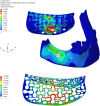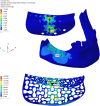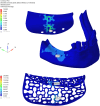Effect of different titanium mesh thicknesses on mechanical strength and bone stress: a finite element study
- PMID: 40835922
- PMCID: PMC12366005
- DOI: 10.1186/s12903-025-06704-w
Effect of different titanium mesh thicknesses on mechanical strength and bone stress: a finite element study
Abstract
Background: This study aimed to investigate the influence of different titanium mesh thicknesses (0.1 mm, 0.2 mm, and 0.3 mm) on mechanical durability and stress distribution in guided bone regeneration using finite element analysis (FEA).
Methods: Three-dimensional mandibular bone models were reconstructed from cone-beam computed tomography (CBCT) data of a patient with a posterior alveolar defect. Custom titanium meshes with varying thicknesses were designed and virtually applied to the defect area. All models were subjected to a vertical force of 30 N to simulate masticatory loading. FEA simulations were performed using ALTAIR Hypermesh and OptiStruct software to evaluate von Mises stress distribution across the mesh, graft, and bone.
Results: The 0.1 mm mesh exhibited the highest stress concentrations (981.569 MPa), indicating a high risk of plastic deformation and potential graft damage (35.287 MPa). The 0.2 mm mesh provided moderate protection with improved stress distribution (mesh: 452.218 MPa, graft: 11.589 MPa). The 0.3 mm mesh showed the best mechanical performance, with the lowest stress values on both the mesh (226.205 MPa) and the graft (7.785 MPa). Bone stress remained below critical thresholds in all models.
Conclusion: Mesh thickness significantly affects the mechanical behavior and stress shielding capacity of titanium meshes in GBR applications. A thickness of 0.3 mm offers the most reliable mechanical performance. However, 0.2 mm meshes may serve as a viable alternative in cases requiring greater flexibility or lower cost, with caution toward borderline graft stress.
Keywords: Bone grafting; Finite element analysis; Guided bone regeneration; Mesh thickness; Titanium mesh.
© 2025. The Author(s).
Conflict of interest statement
Declarations. Ethics approval and consent to participate: Ethical approval for this study was obtained from the Clinical Research Ethics Committee of Istanbul University, Faculty of Dentistry (Approval No: 2024/67), in accordance with the Declaration of Helsinki. Informed consent to participate was obtained from the participant in the study. Consent for publication: Written informed consent for publication was obtained from the patient. All data presented are anonymized, and no identifiable personal information is included. Competing interests: The authors declare no competing interests.
Figures






Similar articles
-
Analysis of optimizing Bicon short implant placement in posterior mandible with type II bone.BMC Oral Health. 2025 Jul 25;25(1):1239. doi: 10.1186/s12903-025-06559-1. BMC Oral Health. 2025. PMID: 40713566 Free PMC article.
-
Effect of Bone Quality, Implant Length, and Loading Timing on Stress Transmission in the Posterior Mandible: A Finite Element Analysis.Bioengineering (Basel). 2025 Aug 20;12(8):888. doi: 10.3390/bioengineering12080888. Bioengineering (Basel). 2025. PMID: 40868400 Free PMC article.
-
Comparison of Subperiosteal Implant Designs Applied to Atrophic and Edentulous Mandible Under Traumatic Forces: 3D Finite Element Analysis.J Oral Implantol. 2025 Jul 15;51(3):295-303. doi: 10.1563/aaid-joi-D-25-00073. J Oral Implantol. 2025. PMID: 40376767
-
Comparison between CAD/CAM titanium mesh vs. conventional titanium mesh in bone regeneration: a systematic review and meta-analysis.Int J Implant Dent. 2025 Aug 22;11(1):55. doi: 10.1186/s40729-025-00643-5. Int J Implant Dent. 2025. PMID: 40844656 Free PMC article. Review.
-
Alveolar ridge reconstruction with titanium meshes: a systematic review of the literature.Med Oral Patol Oral Cir Bucal. 2014 Nov 1;19(6):e639-46. doi: 10.4317/medoral.19998. Med Oral Patol Oral Cir Bucal. 2014. PMID: 25350597 Free PMC article.
References
-
- Singh G, Ramamurty U. Boron modified titanium alloys. Prog Mater Sci. 2020;111: 100653.
-
- Zigdon-Giladi H, Michaeli-Geller G, Bick T, Lewinson D, Machtei E. Human blood-derived endothelial progenitor cells augment vasculogenesis and osteogenesis. J Clin Periodontol. 2015;42(1):89–95. - PubMed
MeSH terms
Substances
LinkOut - more resources
Full Text Sources

